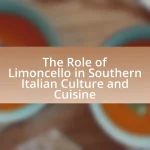Classic Italian cocktails are traditional beverages originating from Italy, known for their distinctive flavors and ingredients, such as the Negroni, Spritz, and Bellini. The article explores the historical origins of these cocktails, influenced by Italy’s cultural and social changes, and highlights key ingredients like vermouth, Campari, and Prosecco. It also examines the significance of food pairings, detailing how specific dishes enhance the tasting experience of these cocktails, while providing best practices for serving and enjoying them. Additionally, the article addresses common mistakes in pairing and the principles that lead to successful combinations of cocktails and food.

What are Classic Italian Cocktails?
Classic Italian cocktails are traditional drinks that originate from Italy, characterized by their unique flavors and ingredients. Notable examples include the Negroni, made with gin, vermouth, and Campari; the Spritz, typically composed of Prosecco, Aperol, and soda water; and the Bellini, which combines Prosecco with peach puree. These cocktails reflect Italy’s rich culinary heritage and are often enjoyed as aperitifs, enhancing the dining experience by stimulating the appetite.
How did Classic Italian Cocktails originate?
Classic Italian cocktails originated in the late 19th century, primarily influenced by the cultural and social changes in Italy during that time. The introduction of vermouth in the 1780s and the subsequent rise of aperitivo culture in cities like Turin and Milan led to the creation of iconic drinks such as the Negroni and the Americano. These cocktails were often crafted to enhance social gatherings and dining experiences, reflecting Italy’s emphasis on food and drink pairings. The popularity of these cocktails grew as they became staples in Italian bars, showcasing a blend of local ingredients and traditional recipes that have persisted into modern cocktail culture.
What historical influences shaped these cocktails?
Classic Italian cocktails have been shaped by a variety of historical influences, including regional agricultural practices, trade routes, and cultural exchanges. The introduction of vermouth in the 18th century, for example, was influenced by the availability of local herbs and spices, which were used to create distinct flavors that characterize Italian cocktails. Additionally, the Italian Renaissance fostered a culture of innovation in gastronomy and mixology, leading to the creation of iconic drinks like the Negroni and Spritz. The post-World War II era saw a resurgence in cocktail culture, influenced by American trends and the global popularity of Italian cuisine, further solidifying the place of these cocktails in both Italian and international drinking culture.
Which regions in Italy are known for their cocktails?
The regions in Italy known for their cocktails include Lombardy, particularly Milan, which is famous for the Negroni and the Sbagliato; Veneto, known for the Spritz; and Campania, where the Limoncello is a popular choice. Lombardy’s cocktail culture is highlighted by the historical significance of Milan as a hub for mixology, while Veneto’s Spritz has gained international acclaim, originating from the Venetian tradition. Campania’s Limoncello, made from local lemons, showcases the region’s agricultural heritage and is often enjoyed as a digestif.
What are the key ingredients in Classic Italian Cocktails?
The key ingredients in Classic Italian Cocktails include vermouth, Campari, gin, and Prosecco. Vermouth serves as a fortified wine base, while Campari adds a bitter flavor profile. Gin contributes botanical notes, and Prosecco provides effervescence and sweetness. These ingredients are foundational in cocktails such as the Negroni, Spritz, and Americano, which are staples in Italian cocktail culture. The combination of these elements creates a balance of flavors that is characteristic of Italian mixology.
How do Italian spirits differ from other spirits?
Italian spirits differ from other spirits primarily in their unique production methods and flavor profiles, which are often influenced by regional ingredients and traditional recipes. For example, Italian spirits like Grappa are made from grape pomace, while Amaro is a herbal liqueur that incorporates a variety of botanicals, resulting in complex flavors that are distinct from spirits produced elsewhere. Additionally, many Italian spirits emphasize a balance of sweetness and bitterness, which is less common in spirits from other countries. This focus on local ingredients and traditional craftsmanship contributes to the rich diversity and cultural significance of Italian spirits in the context of classic cocktails and food pairings.
What role do fresh ingredients play in these cocktails?
Fresh ingredients are essential in classic Italian cocktails as they enhance flavor, aroma, and overall quality. The use of fresh herbs, fruits, and juices contributes to a vibrant taste profile, making the cocktails more refreshing and enjoyable. For instance, fresh basil in a Negroni adds aromatic complexity, while freshly squeezed citrus juice in a Spritz provides brightness and balance. Studies show that cocktails made with fresh ingredients can have significantly higher consumer preference ratings compared to those made with pre-packaged or artificial components, underscoring the importance of freshness in cocktail preparation.
What are some popular Classic Italian Cocktails?
Some popular classic Italian cocktails include the Negroni, Spritz, and Bellini. The Negroni, made with equal parts gin, Campari, and sweet vermouth, originated in Florence in the early 20th century and is known for its bitter-sweet flavor. The Spritz, traditionally made with Prosecco, Aperol, and soda water, is a refreshing aperitif that hails from the Veneto region. The Bellini, a blend of Prosecco and peach purée, was created in Venice and is celebrated for its fruity and light profile. These cocktails are integral to Italian culture and are often enjoyed as part of social gatherings and meals.
What is the recipe for a Negroni?
The recipe for a Negroni consists of equal parts gin, Campari, and sweet vermouth, typically 1 ounce each. To prepare the cocktail, combine the ingredients in a mixing glass filled with ice, stir until well chilled, and strain into a rocks glass filled with ice. Garnish with an orange twist. The Negroni is a classic Italian cocktail, believed to have originated in Florence in the early 20th century, showcasing a balance of bitter and sweet flavors that has made it a staple in cocktail culture.
How is an Aperol Spritz prepared?
An Aperol Spritz is prepared by combining three parts Prosecco, two parts Aperol, and one part soda water in a glass filled with ice. This classic Italian cocktail is typically garnished with an orange slice to enhance its flavor and presentation. The balance of ingredients creates a refreshing drink, making it popular as an aperitif in Italy and beyond.

How do Food Pairings Enhance Classic Italian Cocktails?
Food pairings enhance classic Italian cocktails by complementing and elevating their flavors, creating a more balanced and enjoyable tasting experience. For instance, the bitterness of an Aperol Spritz is beautifully offset by the saltiness of cured meats like prosciutto, while the herbal notes in a Negroni are enhanced by the richness of cheese, such as Parmigiano-Reggiano. This synergy between food and cocktails not only highlights the individual characteristics of each but also encourages a deeper appreciation of Italian culinary traditions, as evidenced by the Italian practice of aperitivo, where drinks and snacks are enjoyed together to stimulate the palate.
Why is food pairing important with cocktails?
Food pairing is important with cocktails because it enhances the overall dining experience by balancing flavors and textures. When cocktails are paired with complementary foods, the taste of both the drink and the dish is elevated, creating a harmonious interaction that can highlight the nuances of each. For example, a bitter Negroni can be balanced with rich, fatty foods like charcuterie, which helps to soften the drink’s intensity. This principle is supported by studies in gastronomy that show how flavor compounds interact, suggesting that well-paired food and cocktails can lead to a more enjoyable and memorable meal.
How do flavors in food complement cocktail ingredients?
Flavors in food complement cocktail ingredients by enhancing the overall taste experience through balance and contrast. For example, a citrusy cocktail like a Negroni pairs well with rich, savory foods such as charcuterie, as the acidity of the cocktail cuts through the fat, creating a harmonious blend. Additionally, herbal notes in cocktails like a Spritz can elevate the flavors of fresh salads or seafood, as the botanicals in the drink echo the freshness of the ingredients. This synergy is supported by the principle of flavor pairing, which suggests that complementary tastes can enhance the enjoyment of both food and drink, leading to a more satisfying dining experience.
What are the principles of pairing food with cocktails?
The principles of pairing food with cocktails involve balancing flavors, matching intensity, and considering texture. Balancing flavors means selecting cocktails that complement or contrast the taste profiles of the food, such as pairing a bitter cocktail with rich, fatty dishes to enhance the overall experience. Matching intensity requires aligning the strength of the cocktail with the robustness of the food; for example, a bold cocktail pairs well with hearty dishes, while lighter cocktails suit delicate foods. Considering texture involves harmonizing the mouthfeel of both the food and the cocktail, such as pairing creamy dishes with cocktails that have a refreshing acidity to cleanse the palate. These principles ensure a cohesive dining experience that enhances both the food and the cocktail.
What types of food pair well with Classic Italian Cocktails?
Classic Italian cocktails pair well with antipasti, seafood dishes, and light pasta. Antipasti, such as cured meats, cheeses, and olives, complement the flavors of cocktails like Negroni and Aperol Spritz. Seafood dishes, particularly those featuring shrimp or calamari, enhance the refreshing qualities of these drinks. Light pasta, especially with olive oil or tomato-based sauces, also works well, as it balances the cocktails’ bitterness and acidity. These pairings are rooted in Italian culinary traditions, where food and drink are designed to enhance each other’s flavors.
Which appetizers are best suited for a Negroni?
The best appetizers suited for a Negroni include olives, charcuterie, and bruschetta. These appetizers complement the Negroni’s bitter and herbal notes, enhancing the overall tasting experience. Olives provide a salty contrast, while charcuterie offers rich flavors that balance the cocktail’s complexity. Bruschetta, with its fresh toppings, adds a refreshing element that pairs well with the drink’s intensity.
What main courses complement an Aperol Spritz?
Main courses that complement an Aperol Spritz include seafood pasta, grilled vegetables, and light salads. Seafood pasta, such as linguine with clams, pairs well due to its fresh flavors that balance the bitterness of the cocktail. Grilled vegetables, often seasoned with olive oil and herbs, enhance the drink’s citrus notes. Light salads, particularly those with citrus dressings, provide a refreshing contrast to the Aperol Spritz’s sweetness. These pairings are supported by the cocktail’s origins in Italian cuisine, where fresh, vibrant flavors are emphasized.

What are the Best Practices for Enjoying Classic Italian Cocktails with Food?
To enjoy classic Italian cocktails with food, it is essential to pair them thoughtfully to enhance both the drink and the meal. Classic Italian cocktails, such as Negroni or Aperol Spritz, typically complement lighter dishes like antipasti, seafood, or salads, as their flavors can balance the richness of the food. For instance, the bitterness of a Negroni pairs well with salty cured meats, while the refreshing citrus notes of an Aperol Spritz enhance the flavors of fresh vegetables and cheeses.
Additionally, serving cocktails at the appropriate temperature and in suitable glassware can elevate the experience; for example, serving a Negroni in a rocks glass with ice allows the drink to maintain its chill while releasing its aromatic qualities. Historical context supports these pairings, as Italian dining culture emphasizes the harmony of flavors, making it a tradition to enjoy cocktails as an aperitivo before meals.
How can one create a balanced cocktail and food experience?
To create a balanced cocktail and food experience, one should ensure that the flavors of the cocktail complement the dish being served. For instance, a classic Negroni, with its bitter and herbal notes, pairs well with rich foods like charcuterie or aged cheeses, as the bitterness cuts through the fat. This principle is supported by the concept of flavor balancing, where contrasting flavors enhance the overall dining experience. Additionally, considering the intensity of both the cocktail and the food is crucial; a light spritz should accompany lighter fare, while a robust cocktail can stand up to heartier dishes. This approach is validated by culinary experts who emphasize the importance of harmony between food and drink for an enjoyable meal.
What tips can enhance the enjoyment of cocktails and food together?
To enhance the enjoyment of cocktails and food together, focus on complementary flavors and textures. Pair cocktails with dishes that either enhance or contrast the primary flavors of the drink; for example, a bitter Negroni pairs well with rich, fatty foods like charcuterie, as the bitterness cuts through the richness. Additionally, consider the temperature of both the cocktail and the food; serving a chilled cocktail with a warm dish can create a delightful contrast. Research indicates that matching the intensity of flavors between cocktails and food can significantly elevate the dining experience, as seen in studies on flavor pairing by chefs and sommeliers.
How should one serve cocktails alongside food for maximum effect?
To serve cocktails alongside food for maximum effect, one should carefully match the flavors and characteristics of the cocktails with the dishes being served. For instance, a classic Negroni, with its bitter and herbal notes, pairs well with rich, savory foods like charcuterie or aged cheeses, enhancing the overall dining experience. This pairing is supported by the principle of balancing flavors; the bitterness of the cocktail can cut through the richness of the food, creating a harmonious taste profile. Additionally, serving cocktails at the appropriate temperature and in suitable glassware can elevate the presentation and enjoyment, as studies show that visual appeal significantly influences taste perception.
What common mistakes should be avoided when pairing cocktails with food?
Common mistakes to avoid when pairing cocktails with food include ignoring flavor profiles, mismatching intensity, and overlooking the importance of balance. Ignoring flavor profiles can lead to combinations that clash rather than complement; for example, pairing a bitter cocktail with a sweet dish can create an unpleasant experience. Mismatching intensity occurs when a strong cocktail overpowers a delicate dish or vice versa, such as serving a robust Negroni with a light seafood dish. Lastly, overlooking balance can result in a lack of harmony; cocktails should enhance the meal, not dominate it, which is crucial for a successful pairing.
How can over-pairing or under-pairing affect the tasting experience?
Over-pairing or under-pairing can significantly diminish the tasting experience by either overwhelming or neglecting the flavors of the food and drink. When over-pairing occurs, the combination of strong flavors can clash, leading to a muddled palate where individual tastes are lost. For instance, pairing a robust cocktail with a heavily seasoned dish may result in one overpowering the other, thus failing to highlight the unique characteristics of both. Conversely, under-pairing can leave the palate unfulfilled, as a delicate cocktail may not complement a rich dish, leading to a disjointed experience where neither element enhances the other. Research indicates that successful pairings enhance the overall sensory experience, making it crucial to find a balance that allows both the cocktail and food to shine.
What are the signs of a successful cocktail and food pairing?
A successful cocktail and food pairing is indicated by complementary flavors, balanced textures, and enhanced overall dining experience. When the cocktail’s taste profile harmonizes with the food, such as a bitter Negroni accentuating the richness of a charcuterie board, it creates a cohesive flavor experience. Additionally, the pairing should maintain a balance in intensity; for example, a light Aperol Spritz pairs well with fresh seafood, allowing both elements to shine without overpowering each other. The overall enjoyment of the meal is heightened, as evidenced by positive feedback from diners who appreciate the synergy between the drink and the dish.










